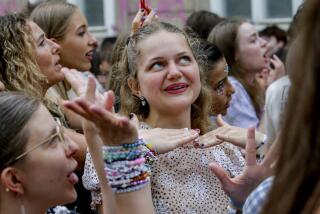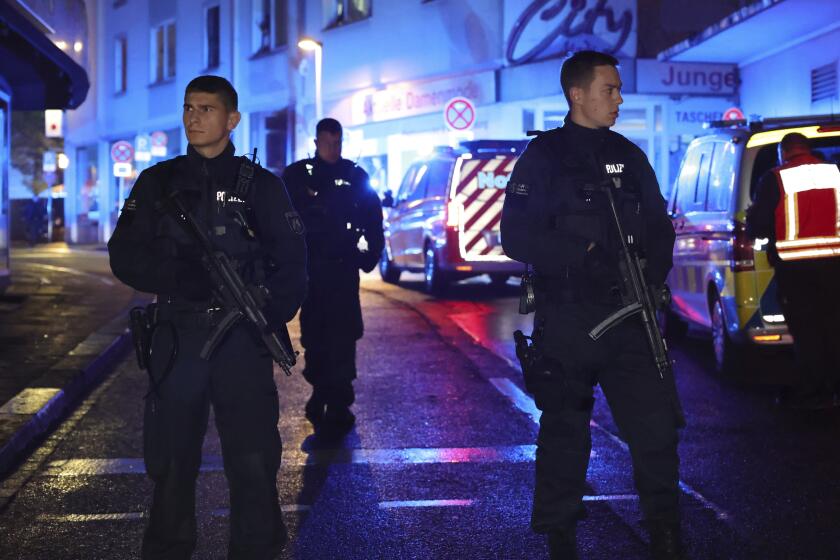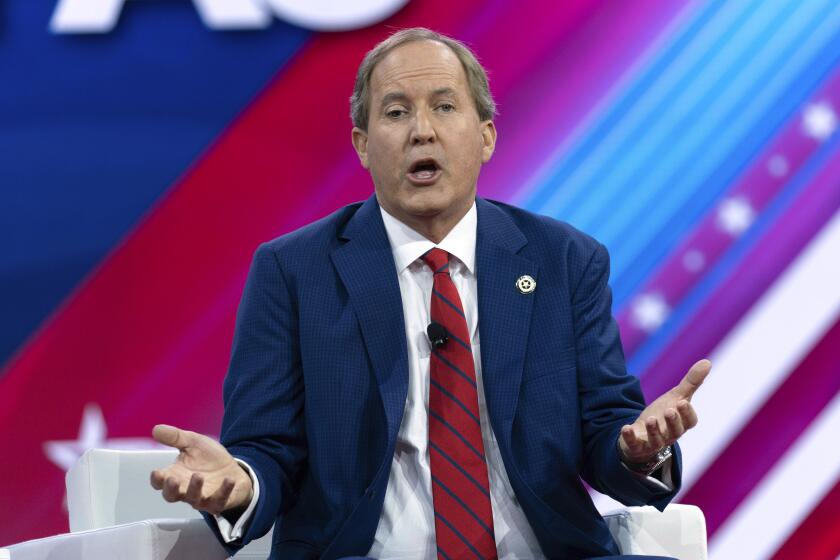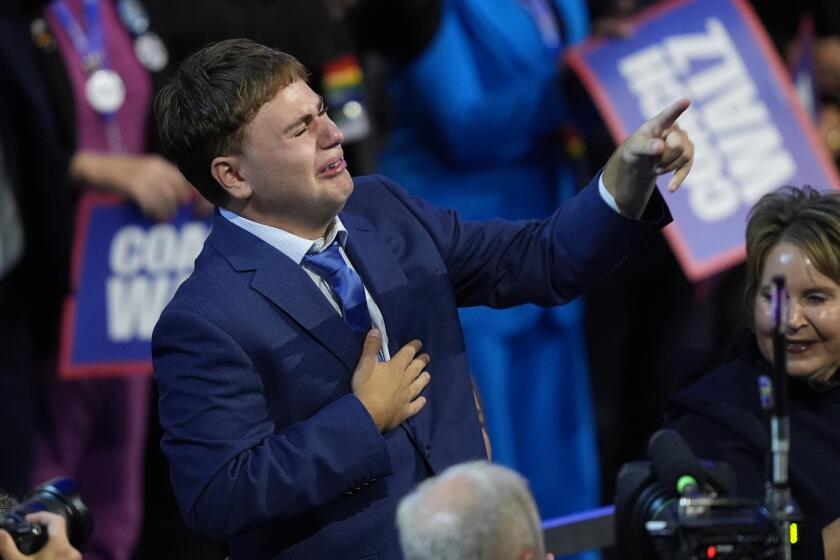Eight Suspects Seized in Plot to Bomb U.N., Other N.Y. Targets : Terrorism: Alleged attack plans also focused on commuter tunnels and political figures. Two of those held may be linked to the trade center blast.
An alleged plot to bomb the United Nations, the Lincoln and Holland tunnels and the FBI’s headquarters in Manhattan was thwarted Thursday when police and federal agents raided a garage and arrested eight suspected terrorists, including two linked to the attack on the World Trade Center in February.
Officials said that the suspects were planning a day of terrorism unprecedented in any American city and that agents were forced to act because they feared the scheme rapidly was reaching fruition.
“As we entered the bomb factory, the suspects . . . were actually mixing the witches’ brew,” said James Fox, the assistant FBI director who heads the New York office. “We entered so fast, some of the subjects said they didn’t realize strangers were in the bomb factory until they had the handcuffs being put on them.”
In addition to the buildings and tunnels--high visibility targets with the potential for a massive loss of life--a number of public figures may have been targeted for assassination, sources said, including U.N. Secretary General Boutros Boutros-Ghali, New York Sen. Alfonse M. D’Amato (R-N.Y.) and Brooklyn Assemblyman Dov Hikind--a supporter of Rabbi Meir Kahane, the slain founder of the Jewish Defense League.
The alleged scheme dramatically escalated the potential for terror. Sources said that the plans included killing guards protecting the Jacob K. Javits Federal Office Building, site of the FBI’s field office. Thousands of motorists could have perished in the tunnels linking New York and New Jersey beneath the Hudson River. The toll in the 38-story steel and glass U.N. headquarters alongside the East River could have been devastating.
“This is the work of very dangerous people,” said Police Commissioner Raymond W. Kelly.
Officials stressed that the manhunt was continuing, but the arrests and the audacity of the plot erased the theory that the trade center bombing on Feb. 26, in which six people were killed and more than 1,000 others were injured, was an isolated act by a single terrorist cell.
The FBI said it foiled the latest conspiracy after it managed to plant an informant in the midst of the group. This informant, who was not identified, was given $300 by the alleged conspirators to rent a “safehouse to build bombs” and accompanied the plotters on their surveillance of the targets.
But police and federal agents managed to plant both microphones and video cameras in the safehouse--a one-time soda distribution plant in the Jamaica section of Queens. As the FBI both saw and heard the suspects mixing bomb-making chemicals in large, yellow 55-gallon drums, they decided it was time to move.
“The public safety factor became the overriding consideration,” Fox said. “We had to act.”
Police and the FBI rolled up the building’s graffiti-covered metal door and burst into the garage to make arrests. They were greeted by the smell of chemicals. “The fumes were overpowering,” Fox said.
Five suspects were seized in the bomb factory and three others were arrested a short time later elsewhere in New York and New Jersey.
Authorities identified the alleged ringleader as Siddig Ibrahim Siddig Ali, 32, of Jersey City, N.J. His lawyer, William Kunstler, said Siddig worked for three years as a private security guard and more recently sold clothing at street fairs. Siddig also has ties to Sheik Omar Abdul Rahman, the fiery Muslim cleric who was spiritual leader to several of the trade center bombing suspects but who has not been charged in connection with the blast.
Abdul Rahman said in a hastily called news conference Thursday that he had known Siddig for about six months. The cleric said Siddig was his translator and spoke perfect English. “I don’t know anything about him except that he is a fine young man,” said Abdul Rahman, denying any involvement in the latest alleged bomb plot.
“I did not do anything to provoke American law,” Abdul Rahman said. “My lectures and speeches will not inspire anybody to do anything.” He said his home was searched Thursday by the FBI and that agents broke down his door and “pushed me and pulled me around.”
The cleric charged that he was treated “in a very savage way” but that the agents apologized when they left.
Officials said Siddig, like four of the other defendants, immigrated to the United States from Sudan. Sudan is the site of training camps for Islamic extremist groups, including some based in other Muslim countries. It is a refuge for opponents of the Egyptian government.
According to court papers, Siddig told the FBI’s informant that he and others were involved in preparations for the bomb that detonated at the trade center. He said he participated in a test explosion of materials used in that blast along with Clement Rodney Hampton-El, another of the suspects arrested Thursday.
Siddig told the informant, according to an FBI affidavit, that the World Trade Center blast was a message: “We can get you anytime.”
At a news conference at police headquarters in Manhattan, U.S. Atty. Mary Jo White disputed that threat.
“Law enforcement’s answer is: ‘No, you cannot,’ ” White said. “The message that these arrests and prosecutions should send is that we will not be driven from our community, we will not live in fear and we will not permit the likes of these defendants to terrorize our city.”
She indicated that Siddig and Hampton-El, 24, could be charged in the trade center case. Six defendants have been directly charged with that bombing. A seventh has been accused of hindering the federal investigation.
Late Thursday afternoon, all eight suspects in the latest alleged plot were brought before U.S. Magistrate Barbara Lee in a heavily guarded courtroom. All wore close-cropped beards and were dressed in work clothes, expect for Hampton-El, who was attired in a flowing white gown and white skull cap. They sat with heads bowed at a long defense table alongside their lawyers as Lee read them their rights and asked if they were familiar with the charges against them.
The magistrate did not allow them to enter pleas pending presentation of a formal indictment, possibly next week.
In addition to Siddig and Hampton-El, the other suspects were:
Fadil Abdelghani, residency not known; Amir Abdelghani, 33, of Jersey City; Fares Khallafalla, 31, of Jersey City; Tarig Elhassan, 38, of Manhattan; Victor Alvarez of Jersey City and Mohammad Saleh of Yonkers, N.Y.
If convicted of the separate charges of conspiracy to destroy buildings used in interstate commerce and attempts to destroy the buildings, they could face 15 years in prison.
“We anticipate filing further charges which will increase the maximum,” White said.
The federal complaint spelled out a chilling scenario starting May 7 when Siddig allegedly met with the confidential informant in Jersey City and discussed detonating a car bomb at the United Nations. Siddig said “he has connections” that would allow him access to the U.N. complex.
The FBI requested information on diplomats from Libya and the Sudan as part of the widening investigation.
According to the complaint, Siddig and the informant discussed renting a safehouse to build the bomb and measures needed to ensure security.
The complaint charged that Siddig “took responsibility” for obtaining explosives and personnel to carry out the bombing and for surveillance of the U.N.’s headquarters. The informant was ordered to build bombs, obtain timing devices and find a safehouse.
“Fearing law enforcement surveillance, Siddig labeled the United Nations building with the code name ‘the big house’ for purposes of further discussions,” court papers said. At a meeting on May 18, when the Federal Building was named as a target, that structure was given the code name “the center.”
On May 27, the plotters tested a bomb timing device in the safehouse, according to the documents. On Tuesday, they traveled to New Jersey to get guns. On an earlier trip to Philadelphia, Siddig and the informant tried to get explosives. Siddig allegedly told the informant that he and his family were prepared to leave the country and that he would be able to arrange for a visa for the informant after the bombing or would get him out of the country without one, if necessary.
During the series of meetings, Siddig allegedly said that several targets would be bombed and that Hampton-El could provide hand grenades. As the plot developed, it was decided that the United Nations would be bombed first, followed by the two tunnels and the Federal Building. Fires would be set near the tunnels as a diversion.
Military and government targets also were discussed as potential bombing sites. They were not named in the complaint.
Last Sunday, Siddig and the informant “proceeded to a remote area of Connecticut for the purposes of conducting a test explosion” with some of the chemicals mixed at the safehouse. Wednesday, two unidentified men transported fuel to the safehouse from a gasoline station Saleh operated in Yonkers, the court papers charged.
Neighbors said Thursday that they witnessed a lot of activity at the safehouse. They said that about two months ago, they began seeing men and two women entering and leaving the building. But it was not until the raiding party broke into the garage that the scope of what was happening became clear.
Informed by phone in Geneva that his name was included on a hit list, Boutros-Ghali said through a U.N. official, “It’s happened before, and it will happen again.” He had no other comment.
D’Amato was less reticent. The senator said that he was targeted because he has called for the death penalty for terrorists and the expulsion of Abdul Rahman.
Hikind said top police officials informed him of the alleged plot in early May and, like D’Amato, he was given police protection.
Times staff writers Ronald J. Ostrow, Robin Wright, Norman Kempster and Stanley Meisler in Washington, Rick Serrano in New Jersey, and New York bureau researcher Lynette Ferdinand contributed to this story.
* SUSPECT’S BELONGINGS: Fares Khallafalla had canister of plaster of Paris, letter from attorney William Kunstler. A22
Terrorists’ Hit List
The targets for bombing allegedly included the two 1.5-mile highway tunnels that link New York City to New Jersey, the United Nations headquarters and the office building that houses the FBI in New York.
SEQUENCE Numbers show the order in which the targets were to be hit. It was unclear which tunnel would be hit first. The World Trade Center was bombed Feb. 26. 1. United Nations 2. Holland Tunnel 2. Lincoln Tunnel 3. Jacob Javits Fed. Building
More to Read
Sign up for Essential California
The most important California stories and recommendations in your inbox every morning.
You may occasionally receive promotional content from the Los Angeles Times.






